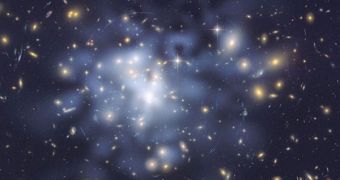NASA experts are pleased to announce the creation of the most detailed map showing the distribution of dark matter around the Universe. The readings were taken using the Hubble Space Telescope.
In order to conduct the survey, astronomers from the American space agency used an observations technique called gravitational lensing, which they applied to the Abell 1689 galaxy supercluster.
The formation, which lies in the constellation Virgo, is one of the most massive ever identified, and it lies at a distance of about 670 megaparsecs (2.2 billion light-years) away from Earth.
Astrophysicists say that its sheer size implies that a huge amount of dark matter exists in and around the cluster. As you all know, dark matter interacts with regular matter via gravity alone.
As such, Abell 1689 exerts a tremendous pull on everything around it, including light. This means that light emitted by galaxies behind it (as viewed from Earth) is heavily distorted and magnified as it passes around the supercluster.
This allows astronomers to essentially use the structure as a giant lens in space. After compensating for the distortions it causes, they can obtain a rather clear image of what's going on behind it, far in space.
In the new study, experts used this approach to map the distribution of dark matter in Hubble's field-of-view. They hope that these results will help them to understand dark energy in great detail.
While dark matter holds galaxies together, and helps form superclusters, dark energy is the force that drives universal expansion at an ever-accelerating rate. This is very clear for modern times, but experts want to learn how things evolved to be this way shortly after the Big Bang.
The study was conducted with Hubble's Advanced Camera for Surveys (ACS) instrument, by a team from the NASA Jet Propulsion Laboratory (JPL) in Pasadena, California, led by expert Dan Coe.
He and his team determined that the concentration of dark matter at the heart of the targeted cluster was a lot higher than initially estimated. The data had been derived from complex computer simulations of how such structure grow.
As such, Abell 1689 now joins a peculiar group of heavily-studies superclusters that all contain vast amounts of dark matter at their cores. If dark energy had indeed prevailed in the early Universe, than such growth would have been impossible.
“Galaxy clusters, therefore, would had to have started forming billions of years earlier in order to build up to the numbers we see today. At earlier times, the Universe was smaller and more densely packed with dark matter,” Coe argues.
“Abell 1689 appears to have been well fed at birth by the dense matter surrounding it in the early Universe. The cluster has carried this bulk with it through its adult life to appear as we observe it today,” the investigator goes on to say.
“The lensed images are like a big puzzle. Here we have figured out, for the first time, a way to arrange the mass of Abell 1689 such that it lenses all of these background galaxies to their observed positions,” Coe adds.
The new data will provide the starting point for the planned Cluster Lensing and Supernova survey with Hubble (CLASH) research initiative, which will pit the famous telescope on a quest to study gravitational lensing in numerous superclusters.
Only structures with vast quantities of hot gas inside are targeted. Experts say that they can be detected after their X-ray emissions, and add that gas accumulates in large amounts only in massive clusters.
The goals of CLASH are fairly simple - detect clues on the early formation of clusters, determine if dark energy exist, and find out its influences on the Universe, SpaceRef reports.

 14 DAY TRIAL //
14 DAY TRIAL //